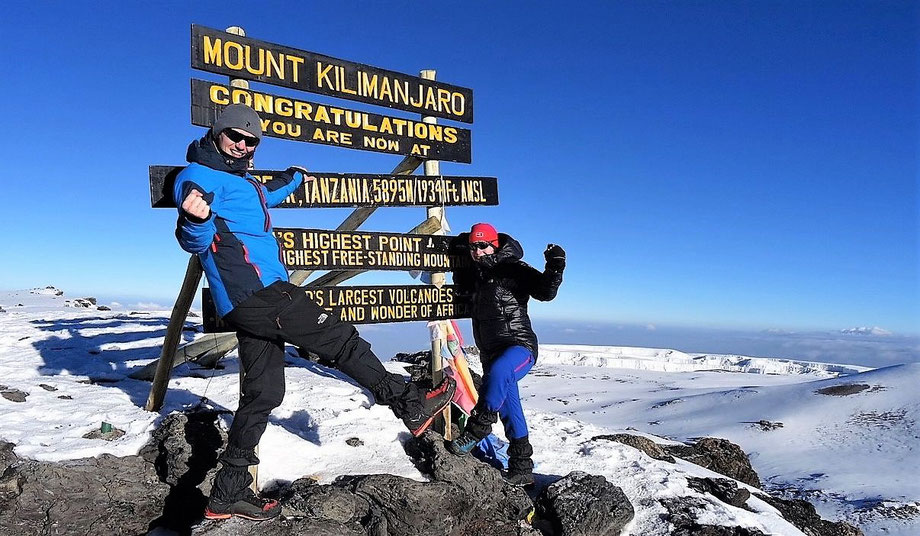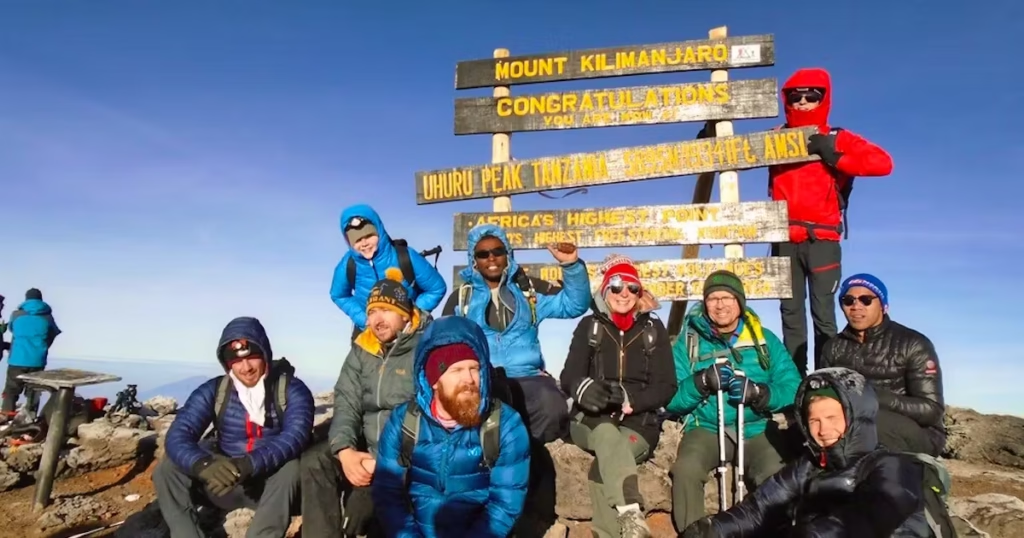Climbing Kilimanjaro: Climbing Kilimanjaro Succuss Rate
Climbing Kilimanjaro, Kilimanjaro rises to an elevation of 5,895 meters (19,341 feet) above sea level. It is the tallest free-standing peak globally and is referred to as the “Roof of Africa.” Mount Kilimanjaro is among the most sought-after tourism destinations in the continent. Annually, it attracts about 40,000 visitors. The journey is exceptionally scenic and does not necessitate advanced climbing expertise. Achieving the summit requires merely a good level of physical fitness. This book was created to assist travelers in preparing for their extraordinary Kilimanjaro Climbing expedition. All the recommendations provided below are derived from our eleven years of experience with Kilimanjaro. During this period, we have facilitated Kilimanjaro climbing expeditions for more than 20,000 individuals.
Frequently asked questions regarding Kilimanjaro
What is the duration required to ascend the mountain?
Ascending Kilimanjaro requires a minimum of 5 days; however, the majority of expeditions span 6 to 8 days, as an extended itinerary markedly enhances acclimatization and elevates the likelihood of summiting. Prolonged itineraries, including alternatives include an overnight stay in the crater, may extend for 10 days or longer.
What is the difficulty level of climbing Kilimanjaro?
Climbing Kilimanjaro presents a moderate challenge yet is attainable for the ordinary individual. With a trustworthy climbing operator and adequate time for acclimatization, summit attainment is feasible for the majority, even in the absence of prior mountaineering experience.

What to pack for Kilimanjaro?
A Kilimanjaro climbing traverses five climatic zones, ranging from tropical jungles to Arctic environments. Temperatures vary from -15°C (5°F) at the top during the night to +20°C (68°F) at the base. The weather is capricious; sunshine might swiftly transition to rain or wind and vice versa. For a secure and comfortable expedition, appropriate attire, footwear, sleeping bag, trekking poles, and further necessities are required. Obtain our complimentary expert-curated packing list to ensure complete preparedness.
Is it feasible for a novice to ascend it?
Kilimanjaro is attainable for novices lacking trekking experience. The primary determinant is not hiking proficiency but enough acclimatization, optimally attained over a 7–8-day itinerary. To enhance your likelihood of attaining the summit, select a reputable outfitter and adhere to your guides’ safety directives. For thoughts regarding your Kilimanjaro ascent, consult “What I Wish I Knew Before Climbing Kilimanjaro” by Georgia Fowkes, a former climber.
What is the best time for Climbing it?
The best times for Climbing Kilimanjaro are late December to early March and mid-June to late October. This period represents the near-ideal weather conditions for Kilimanjaro. While other months experience precipitation, it does not imply the presence of continuous severe downpours. Generally, precipitation commences in the afternoon. This provides trekkers a substantial opportunity for clear weather daily throughout the rainy season. There are also days devoid of precipitation. Further information regarding the seasons of Kilimanjaro is available for reading.
What is the cost of climbing Kilimanjaro?
In 2025, a secure and pleasant 7-day group ascent is priced at approximately $2900. A brief 5-6 day excursion or a seasonally discounted journey costs between $2300 and $2500. This sum encompasses the park entrance fees, constituting approximately 35% of the overall trip expenditure. Any trekking businesses offering lower this amount should be approached with care.
Reduced prices consistently correspond with the exploitation of porters. The personnel of budget operators frequently receive inadequate compensation and nutrition, jeopardizing the safety of both themselves and hikers. Explore the expenses associated with climbing Kilimanjaro in our comprehensive blog post.

What is the best training regimen for the climb?
An intermediate degree of fitness is essential for a comfortable and successful ascent of Kilimanjaro. This indicates that you need to be capable of running 5 km (3 mi) with ease and hiking 10 km (6+ mi) within a day. Optimal training methods encompass swimming, cycling, jogging, and hiking.
What are the risks associated with climbing Kilimanjaro?
The primary hazard on Kilimanjaro is acute mountain sickness resulting from inadequate acclimatization. In extreme instances, it may result in cerebral or pulmonary edema, both of which are life-threatening illnesses responsible for approximately ten fatalities year on the mountain.
Examine additional information regarding mortality on the mountain in our post on Mt. Kilimanjaro death statistics. Fortunately, AMS is readily preventable. Select an itinerary of seven days or more, maintain hydration, and proceed at a leisurely pace to facilitate adequate altitude acclimatization. Expertise in guiding is essential—select an operator whose Kilimanjaro guides are certified Wilderness First Responders, equipped to manage emergencies and evacuations. For further information, refer to our article on acclimatization on Kilimanjaro.
Kilimanjaro climbing Itinerary
Are you intending to ascend Kilimanjaro? Discover our introductory 12-day itinerary, featuring a seven-day ascent of Mount Kilimanjaro. Following the trip, relax with a two-day safari in the breathtaking Tarangire and Ngorongoro national parks. This detailed schedule is optimal for exploring all of Tanzania’s premier sights and encompasses days for arrival, departure, and a designated rest day.

What is the meaning of Kilimanjaro?
The term “Kilimanjaro” has ambiguous roots, however it is thought to derive from the Swahili and Chaga languages, potentially signifying “mountain of greatness” or “shining mountain.” Diverse hypotheses abound, illustrating the region’s profound cultural heritage.
For further information, consult our article that examines the significance of the name “Kilimanjaro”.
Kilimanjaro climbing Itinerary
Researchers anticipate that the glaciers of Kilimanjaro may vanish by 2040 to 2060 as a result of climate change and diminished snowfall. The Furtwängler Glacier, the most prominent remnant, is fast diminishing, underscoring the effects of environmental change on Africa’s highest summit. Explore additional information regarding the Furtwängler and other glaciers on Kilimanjaro in our article.
Who was the inaugural individual to ascend Mount Kilimanjaro?
In 1889, German geographer Hans Meyer and Austrian climber Ludwig Purtscheller became the first individuals to ascend to the peak of Kilimanjaro. Their trip surmounted severe conditions, facilitating the path for subsequent climbers. Discover additional information regarding the inaugural individual to ascend Kilimanjaro in our article.
What is the location of Mount Kilimanjaro?
Mount Kilimanjaro National Park is located in northern Tanzania, East Africa. It is located three degrees south of the equator. Although many of the most renowned panoramic images of Mt. Kilimanjaro have been taken from the Kenyan perspective, all trailheads are situated in Tanzania. Consequently, travelers are permitted just to ascend Mt. Kilimanjaro in Tanzania. The nearest airport is Kilimanjaro International Airport. Numerous Kilimanjaro Climbing expeditions commence at Moshi, the capital of the corresponding region.
What is the route to Mt. Kilimanjaro?
The most convenient method to access Mt Kilimanjaro is via flying into Kilimanjaro International Airport (JRO) in Tanzania. The journey to Moshi, where the majority of climbs commence, takes approximately 50 minutes by car. Prominent airlines including Turkish Airlines, Qatar Airways, KLM, Ethiopian Airlines, and Air France provide flights to JRO.
Alternatively, one may fly into Dar es Salaam and subsequently take a domestic aircraft to Kilimanjaro; however, this option may incur additional expenses for domestic flights and baggage fees. An economical alternative is to fly into Nairobi, Kenya, and subsequently take a bus to Moshi; however, consider the supplementary expenses of a Kenyan transit visa ($21) and the bus fare ($45), resulting in an overall travel duration of approximately seven hours.
What is the height of Mount Kilimanjaro?
Uhuru Peak, the apex of Mount Kilimanjaro, rises to an elevation of 5,895 meters (19,341 feet). However, this does not imply that you will commence your ascent from the very bottom. The majority of hotels in proximity to Kilimanjaro are situated at an elevation of 1,000 meters (3,300 feet) above sea level. The trailheads commence at elevations of 1,600 meters (5,250 feet) and above. Owing to its elevation, Mt. Kilimanjaro is one of the rare locations in East Africa where snow is observed.
